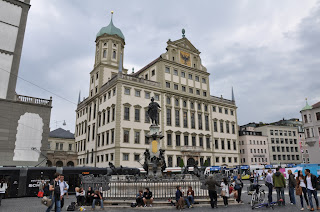.
This weekend we were in France for Emilie's sister Cecile's wedding. And as is customary for French weddings, it took place in the region where the bride is from (in this case, the Jura). Don't feel bad for the groom, though, as the "civil" wedding took place in his hometown of St. Nazaire (northwestern France) back in September.
As this was my first French wedding, I didn't know what to expect going into the weekend. Things definitely started off on a good note, though, when we arrived at the "château" in Syam where the wedding party would be staying for the evening. It was built in 1818 by a wealthy industrialist and its design was inspired by a Renaissance Villa in Northern Italy.
Here's the view from the front door. It's pretty hard to compete with natural beauty such as this.
The interior of the château was equally impressive, with a central rotundra that was the focal point of all four floors.
The wedding took place at a small church in nearby Gillois. The ceremony lasted about an hour and was fairly consistent with a Catholic wedding ceremony in the U.S. (aside from being in French, of course).
Here's the bride and the groom shortly after the ceremony began. The photo also gives a nice feel for the church interior, which was pretty much everything you'd expect from a centuries-old church in the French countryside. While it may be normal for the French to attend a wedding in a place such as this, it was definitely a unique experience for me.
And here are the newlyweds outside the church after being presented as man and wife.
After the wedding we headed back to the château for the the reception, which was held in another building on the property where we were staying. This is where I began to experience the marathon nature of French weddings.
First there was the cocktail reception, which lasted a couple of hours and included all of the guests from the wedding. Basically, French weddings have two tiers of guests: those who are invited just to the cocktail reception and those who are invited to the cocktail reception and the subsequent dinner reception. You'd think that having two tiers of guest would make things a bit awkward, but apparently not.
The highlight of the cocktail reception (at least for Emilie and her aunts) was the bouquet toss. Surprise, surprise, but guess who caught it? Yep...Emilie. I don't know if "caught" it is the right word, actually, as she used rugby-like tactics to take out the opposition and ensure she came down with it. Perhaps a formal protest with the bouquet-toss governing body is also in order given that the bride throwing the bouquet was her sister. Interesting how it ended up in Emilie's hands. I think the fix was in...
The dinner consisted of countless plates (appetizer, multiple main courses, cheese, dessert) and all were great. And throughout, there were various "animations" -- basically speeches with photo slideshows by the best man, the maid of honor (Emilie) and a couple of others.
After dinner, the reception went late into the night. And during this time I noticed a couple clear differences with many of the U.S. weddings that I've been to. First, as the wedding was in the countryside, there was no time cut-off. People stayed as late as they wanted as there was no one to complain about the noise.
Second, the bride and the groom closed down the night. Normally, I feel like the bride and groom are gone before you know it. In this case, however, they were the ones giving the late-night requests to the DJ when few others still remained. I think they definitely did it right.









































